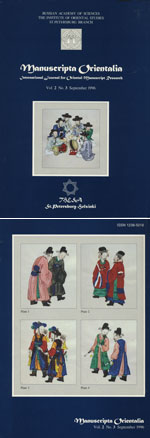|
|
| |

|

|
Tugusheva L. Early Medieval Uighur Records from East Turkestan // Manuscripta Orientalia. Vol. 2. No. 3. September 1996. P. 8—15.
The one-page short texts of different contents from the St. Petersburg Branch of the Institute of Oriental Studies collection, which is published here, belong to the marginal area of literature and business. They can be conventionally described by the term “records” neutral in relation to their genre. Among them are an incantation written on a leaf of paper, household records of expenses and income, writing exercises. Taking into account the scarceness of evidence on the life of the region (especially in the early medieval period), from which they come, records of this kind may serve a valuable source of information.
Four texts are presented in this publication. The first one contains the names of persons in whose name, as we may suggest, the text was written. It contains a wish to overcome difficulties in the earthly life (samsāra). It appears in the form of an elegant verse composed according to all the rules of versification accepted at that time. The text is supplemented with a Sanskrit incantation (dhāranī) transformed after the Uighur fashion. It is titled The Jewel of Chintamani, probably after the name of the famous incantation cited in Buddhist works. It starts with the usual elements characteristic of this kind of incantations: oom (Skr. om) — the solemn confirmation of a prayer and šrin (Skr. śrī) — the sign of the beginning of the liturgy. The text is interesting, first of all, as a characteristic example of East Turkestan poetry and an evidence of the use of poetic forms in the everyday language of that time.
The second text can be defined as a literary exercise. It consists of seven repeated lines (which can be reconstructed as two) expressing the admiration on seeing the mount of Karakorum. The Karakorum range is located in the southwestern part of East Turkestan. From the early medieval Uighur dominion in East Turkestan with its principal cities of Turfan and Beshbalyk it was separated by the Takla-Makan desert. Nevertheless, as we see, this mountain range was at that time well known to the Turkic population of the region. It bore the same name as it bears now and was the source of the equal admiration. It should be taken into account that the name of Karakorum could be a metaphor applied to any high mountain. But even in this case the presence of the name in early medieval texts is noteworthy.
Texts 3 and 4 may be attributed to the category of household documents, records of income and expenses of certain people and communities. Many of the persons named in text 4, as well as in text 1, bear the title of šila — “monk, priest”. It is possible to suggest that the text deals with the distribution of property belonging to some religious community.
К содержанию выпуска...
 PDF-файлы PDF-файлы
Полный текст статьи
Ключевые слова
коллекция ИВР РАН: издания
коллекция ИВР РАН: переводы
коллекция ИВР РАН: факсимиле
рукописи уйгурские
фонд сериндийский
|
|
|
|
Случайная новость: Объявления |
|
25 марта 2024 г. в ИВР РАН пройдет конференция «Актуальные проблемы буддологических и индологических исследований–16». Предлагаем вашему вниманию программу. |
|
Подробнее...
|
|
|
|
|

